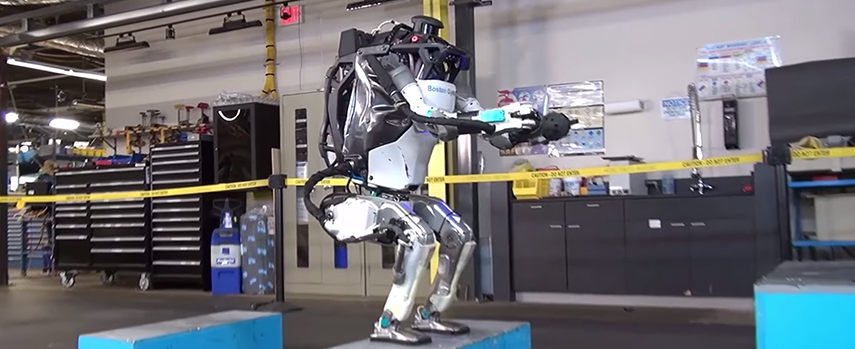Robots and workplace automation are unstoppable

Robots empowered by AI are transforming our workplaces. They’ll greatly contribute to economic growth, productivity and efficiency, whether we like it or not.
There’s something unsettling about watching a humanoid robot happily going about its business, toiling away in a warehouse moving boxes, then being ruthlessly floored by its human colleague and hit with hockey sticks. It feels as though we’re witnessing a one-sided fight, and we can’t help but take pity on the hapless robot.
The prototype for Boston Dynamics’ now world-famous Atlas was being put through its paces. Its handler, for want of a better word, was deliberately making Atlas’ life difficult in order to test the 1.5m-tall robots’ responses. How does it react to a setback? If it is kicked down, will it rise up and continue or flounder on the cold warehouse floor?

In a video from Boston Dynamics, which has almost four million views, Atlas picks up the box and stands upright, moving towards its drop off point with only the task in mind. The handler then takes a hockey stick and knocks the payload from the robot’s hands.

Atlas bends down to retrieve the box, and the handler swipes it away with the stick over and over again. Each time, Atlas readjusts itself and goes for the box again. Slight moments of hesitation, as if letting out a laboured sigh, seem to suggest that Atlas is considering its purpose in a world full of torment.
According to researchers, we can’t help but feel empathetic towards the robot, even though it clearly has no sentience, no feeling and no emotion. Their findings suggest that our neurological patterns are the same as they would be if the subject was human. It’s not a stretch to imagine ourselves in that situation. We know what it feels like to be down-trodden.
The comments section of the robot-abuse video looks ahead, partly tongue-in-cheek, at a future when these images will be used in a war-crimes trial against humans. One user jokes: “When the robots eventually rise up against humanity Boston Dynamics will be the first place to go.” Some are distancing themselves from the abuse in a bid to gain mercy from “our future robot leaders.”
Atlas is just one of four cutting-edge robots developed by Boston Dynamics and, being the most humanoid, we can relate to it. The form and movement are both familiar to us. Much like Spot, which resembles man’s best friend, the dog.

AI and automated robots in the home and workplace
Spot, the nimble four-legged robot, is capable of handling a 14kg payload. Standing at just under a metre, it uses 3D depth perception to move quickly through obstacles, up flights of stairs and over all types of terrain.
Spot’s movements are uncanny. Nightmarish, almost. Unlike Pepper or Aibo, it isn’t going to win over people for its cuteness but, functionally speaking, Spot is as advanced as it gets.
Similar robots have been developed for use in combat situations: disarming roadside bombs and delivering aid to soldiers. However, Spot is destined for the home or the office. Using its articulated arm, Spot can load and unload the dishwasher with ease, take out the rubbish and even bring you a beer, among other things.
Looking beyond home automation, one of the greatest causes of concern for many is the threat to their livelihood. Philosophers and industry commentators have warned us about the dangers of being superseded by AI, and as these technologies develop we become increasingly more aware of the fragility of our place in the workforce.
The McKinsey Global Institute analysed 2000 work activities across 800 occupations. In an overall optimistic report, their research suggests that 30% of those activities, not the jobs as a whole, could become automated. Certain categories of work, including “physical activities in highly predictable and structured environments,” look set to bear the brunt of automation.
They suggest that only 5% of jobs will be completely automated, whereby no human involvement is needed at all. According to McKinsey, 400 million workers in North America could be displaced by 2030, but those will find employment in new occupations developed by increased automation.
“Most workers—from welders to mortgage brokers to CEOs—will work alongside rapidly evolving machines.”
McKinsey Global Institute
In workplace automation, Boston Dynamics is again at the cutting-edge with two robots which could revolutionise the way factories operate.
Handle, which looks eerily like a giant robot chicken, zips around the factory floor on two wheels, moving and packing boxes. At the other end of the factory, Pick, a giant blue arm, uses deep learning to intelligently depalletize and sort shipments.
Between Handle and Pick, and with Atlas roaming around handling smaller items, it’s not difficult to envision a fully automated factory floor.
Automation and artificial intelligence, along with robots, will accelerate the change of required skills in the workplace. Over time, if educational institutions and businesses prepare and adapt to the change, we should be able to transition smoothly into new workflows, new occupations and new ways of thinking about our robot colleagues.
But are we doing enough to prepare and adapt? Will we keep up?